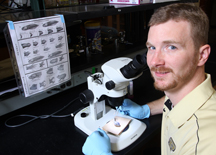Study: Loss of wetland biodiversity increases disease risk in frogs
December 2, 2013
 |
|
Jason Hoverman (Purdue Agricultural Communication photo/Tom Campbell) |
WEST LAFAYETTE, Ind. - Amphibians in species-poor wetlands have a higher risk of becoming infected with a virulent parasite than those in wetlands with a rich diversity of species, according to a Purdue University finding that sheds light on how biodiversity moderates the transmission of infectious diseases.
In wetlands with a wide variety of both amphibian and parasite species, Pacific chorus frogs are far less likely to become infected with Ribeiroia ondatrae, a trematode that causes limb malformations in frogs and newts.
"The loss of species diversity has major implications for how harmful and deadly diseases are transmitted in nature," said Jason Hoverman, an assistant professor of vertebrate ecology. "While the risk of getting infected with this trematode is largely a factor of how many trematodes are present in the community, we found that disease transmission is also impacted by the number of host species and other parasite species in the system."
The study addresses a paradox of disease ecology: In highly diverse communities, potential hosts are less likely to become infected with harmful pathogens, even though these communities contain more parasites overall. In complex wetland systems, frogs may carry a greater number of parasites, but hosts and parasites work in tandem to prevent infections by the most virulent pathogens. Reducing parasite diversity as well as host diversity greatly increases a frog's risk of contracting a crippling parasite such as Ribeiroia ondatrae.
The implications of losing biodiversity go beyond wetlands, Hoverman said.
"What is amazing is that we're finding these principles hold true for basically all disease systems, whether human, animal or plant. Because human activities are linked to the loss of biodiversity, there are growing concerns that we could inadvertently influence the emergence of infectious diseases."
About 43 percent of global amphibian populations are declining due to dwindling habitats and a rise in infectious diseases such as ranavirus and Ribeiroia ondatrae. To determine the relationships between disease transmission, amphibian diversity and parasite diversity, Hoverman and researchers from the University of Colorado combined data from 345 wetlands, a laboratory experiment and a controlled outdoor experiment.
"Most disease studies focus either on host diversity or parasite diversity," Hoverman said. "But what we were able to do here was bring those two things together so we could look at the relative contribution of changes in host and parasite diversity on disease risk."
In all three settings, higher host and parasite diversity resulted in fewer Ribeiroia ondatrae infections in Pacific chorus frogs. Increasing the number of amphibian species in a wetland reduced infections by Ribeiroia ondatrae and other parasites, a phenomenon known as the "dilution effect." Increasing the number of other parasite species further reduced trematode infections, highlighting the important role of parasites in regulating disease transmission, Hoverman said. The most diverse wetlands suppressed transmission of Ribeiroia ondatrae from ramshorn snails – the trematode's intermediate host - to frogs by more than 50 percent.
"We always think about the negative connotations of parasites, but having more parasites is not equivalent to greater disease risk," Hoverman said. "Most parasites are fairly benign. Disease risk is really defined as how many virulent parasites are in a community."
The paper, published in the Proceedings of the National Academy of Sciences, is available at http://www.pnas.org/content/110/42/16916.full.
Funding for the research was provided by the David and Lucile Packard Foundation and grants from the U.S. National Science Foundation.
Writer: Natalie van Hoose, 765-496-2050, nvanhoos@purdue.edu
Source: Jason Hoverman, 765-496-3263, jhoverm@purdue.edu
Related website:
Purdue Department of Forestry and Natural Resources
Ag Communications: (765) 494-2722;
Keith Robinson, robins89@purdue.edu
Agriculture News Page

